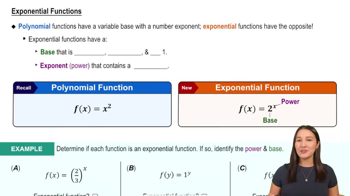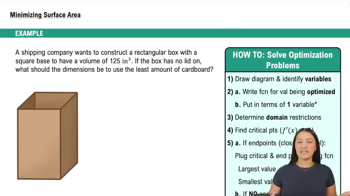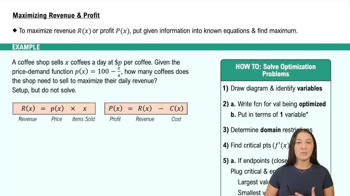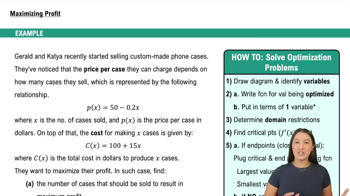Table of contents
- 0. Functions7h 52m
- Introduction to Functions16m
- Piecewise Functions10m
- Properties of Functions9m
- Common Functions1h 8m
- Transformations5m
- Combining Functions27m
- Exponent rules32m
- Exponential Functions28m
- Logarithmic Functions24m
- Properties of Logarithms34m
- Exponential & Logarithmic Equations35m
- Introduction to Trigonometric Functions38m
- Graphs of Trigonometric Functions44m
- Trigonometric Identities47m
- Inverse Trigonometric Functions48m
- 1. Limits and Continuity2h 2m
- 2. Intro to Derivatives1h 33m
- 3. Techniques of Differentiation3h 18m
- 4. Applications of Derivatives2h 38m
- 5. Graphical Applications of Derivatives6h 2m
- 6. Derivatives of Inverse, Exponential, & Logarithmic Functions2h 37m
- 7. Antiderivatives & Indefinite Integrals1h 26m
- 8. Definite Integrals4h 44m
- 9. Graphical Applications of Integrals2h 27m
- 10. Physics Applications of Integrals 2h 22m
5. Graphical Applications of Derivatives
Applied Optimization
Problem 4.5.50a
Textbook Question
Do dogs know calculus? A mathematician stands on a beach with his dog at point A. He throws a tennis ball so that it hits the water at point B. The dog, wanting to get to the tennis ball as quickly as possible, runs along the straight beach line to point D and then swims from point D to point B to retrieve his ball. Assume C is the point on the edge of the beach closest to the tennis ball (see figure). <IMAGE>
a. Assume the dog runs at speed r and swims at speed s, where r > s and both are measured in meters per second. Also assume the lengths of BC, CD, and AC are x, y, and z, respectively. Find a function T(y) representing the total time it takes for the dog to get to the ball.
 Verified step by step guidance
Verified step by step guidance1
First, understand the problem setup: The dog runs from point A to point D along the beach and then swims from point D to point B in the water. We need to find the total time it takes for the dog to reach the ball at point B.
Identify the variables: Let the distance the dog runs along the beach from A to D be 'z - y', where 'z' is the total distance from A to C and 'y' is the distance from C to D. The distance the dog swims from D to B is 'x'.
Express the running time: The time taken to run from A to D is given by the formula \( \frac{z - y}{r} \), where 'r' is the running speed.
Express the swimming time: The time taken to swim from D to B is given by the formula \( \frac{x}{s} \), where 's' is the swimming speed.
Combine the times to form the total time function: The total time \( T(y) \) is the sum of the running and swimming times, which can be expressed as \( T(y) = \frac{z - y}{r} + \frac{x}{s} \).
 Verified video answer for a similar problem:
Verified video answer for a similar problem:This video solution was recommended by our tutors as helpful for the problem above
Video duration:
2mPlay a video:
Was this helpful?
Key Concepts
Here are the essential concepts you must grasp in order to answer the question correctly.
Optimization
Optimization in calculus involves finding the maximum or minimum values of a function. In this scenario, the dog’s total time to retrieve the ball is the function to be minimized. By analyzing the relationship between the distances and speeds, we can derive a function that represents the total time, which is essential for determining the optimal path the dog should take.
Recommended video:

Intro to Applied Optimization: Maximizing Area
Functions and Variables
A function is a mathematical relationship where each input is associated with exactly one output. In this problem, T(y) is a function of the variable y, which represents the distance the dog runs along the beach. Understanding how to express the total time as a function of y is crucial for applying calculus techniques to find the minimum time.
Recommended video:

Exponential Functions
Derivatives
Derivatives represent the rate of change of a function and are fundamental in finding local extrema. To minimize the total time function T(y), we will need to compute its derivative and set it to zero to find critical points. This process helps identify the optimal distance y that minimizes the time taken for the dog to reach the ball.
Recommended video:

Derivatives

 1:13m
1:13mWatch next
Master Intro to Applied Optimization: Maximizing Area with a bite sized video explanation from Callie
Start learningRelated Videos
Related Practice








